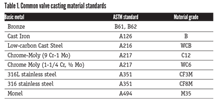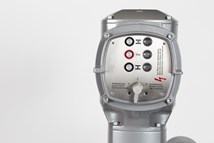Industry Profile: Chris Jones
Chris Jones is the Chair of the VRC Board of Directors.

Chris Jones is the Chair of the VRC Board of Directors. In his role as Director of Final Control Services for Midwest Valve Services, he leads the organization which includes five valve repair facilities throughout the upper Midwest, and maintains more than 35 OEM authorized service relationships. He’s been in the valve repair industry for 25 years, the past 15 with Midwest Valve, and has held a variety of roles including sales and sales management, business development, director and executive team leadership. He’s a graduate of the University of Wisconsin — Madison.
What inspired you to pursue a career in the world of valves and actuators?
My father spent 45 years in the pump, mechanical seal, rotating equipment and valve repair business. Spending time with him at his office and riding along occasionally to deliver fluid sealing products to customers was my initial introduction to the industrial process world at a very young age. Seeing the size of major pulp and paper mills, power plants, chemical refineries and food processing facilities was intriguing to me. His dedication to helping customers solve problems, minimize downtime and improve equipment reliability became ingrained at an early age. I also learned the importance of quality and building things to last. Fast forward to my late teenage years, and the operations manager offered me an opportunity to work in their new service division, which included industrial valve repair. I was in college at the time, and it was a great part-time summer job that took me all over the upper Midwest servicing valves in industrial plants.Two years later, prior to my graduation, the company owner extended a job offer as a salesperson and the rest is history.
Why did you decide to get involved with VMA?
Midwest Valve has been a long-time member of the VMA/VRC. I was provided with an opportunity to represent our organization at VMA/VRC meetings and maintain our highly valued, long-term OEM relationships we’ve had for over 40 years. From that point on, it’s been important to me in helping promote quality, safety and the OEM supply chain message to our VMA/VRC members, end users and manufacturers. I’ve seen the consequences firsthand when companies cut corners and do not maintain as-designed engineering standards. The negative impact and potential loss can be significant to people and equipment. The VMA/VRC plays an important role in our line of work to help drive high standards, promote safety, exchange ideas and technology and advocate for the valve industry as a whole.
Are there any exciting projects or initiatives you are working on that you’d like to highlight to our readers?
You know the old saying, “time is money?” Over the years we’ve found ways to improve efficiency through our repair and documentation processes, which means quicker turnaround time. We have multiple initiatives underway that are focused on streamlining the repair process ranging from data and diagnostics to enhanced welding and machining methods. Customer shutdowns, turnarounds and outages (STOs) are getting shorter and we’re aiming to help meet or exceed that industry demand.
How do you stay abreast with changes in the valve/actuator industry?
Networking is key. We have a vast network of relationships across the industry including other repair companies, OEMs, suppliers, industry trade associations and most importantly end users — our customers. Participating in the VMA/VRC has helped evolve those relationships. I’ve also participated on a couple of advisory boards over the past seven years that help me stay connected with peers across the valve industry. In addition, collaborating closely with our customers on maintaining their assets helps provide feedback to manufacturers. This information sharing assists with new product development, the creation of specialty tooling, better repair and test methods, improved asset reliability, troubleshooting industry process challenges and making a positive impact on the success and sustainability of our customers’ operations.
What do you think the biggest challenges are for valve manufacturers? For end users?
With a high number of retirements on the horizon and a shrinking workforce, it’s leaving a void not only in numbers but also in technical expertise. Interest in trade schooling seems to be on the rise, which is great to hear. Partnering with tech/trade schools, finding good talent and providing a good career development path to retain employees is critical.
Are there any emerging trends or technologies that you are particularly excited about?
Valve and actuation diagnostics have advanced significantly along with their ability to measure real-time performance and provide alerts when valve or actuation services are required. Advancements in predictive analytics applied to these smart devices will be a tremendous benefit to the process industry. From a repair standpoint, incorporating the use of automated and/or robotic welding and machining into the repair business is even more exciting to me. It challenges us to move from the manual way of doing things (which there is still a place for that technology) to a more efficient, repeatable and precise way of repairing and improving the longevity of components.
What advice would you give someone who wants to explore a career in our industry or one of our end markets?
Working in this industry provides endless opportunities to provide a positive impact in more ways than most people realize. It’s amazing to think about the decisions and actions we take each day and how they can have a profound impact on the success of plant performance, efficiency, safety, profitability, employee sustainability, environmental impact and the list goes on. It truly has a butterfly effect in so many ways.
Is there a piece of advice you were given that has stuck with you?
“You put your best people on your best opportunities.” Success in running a good business is having great people. Recruit honest, hardworking talent, treat them with respect, provide opportunities to gain experience and develop them to their highest potential.
Tell us about your time outside of work.
Spending time on the water with our family is a great way to relax and enjoy the outdoors. I also enjoy home improvement projects, working on cars, boats, snowmobiles, or anything for that matter with an engine that goes fast. My grandfather was a mechanic and that gene was passed on to me.
Do you have a secret talent that would surprise or delight our readers?
Being around machining and welding equipment for years, I’ve developed a passion for seeing chips and sparks fly. Engineering a concept and drafting parts and components has become a personal area of interest. After reading a biography about Mercury Marine founder Carl Kiekhaefer, it gave me the motivation to turn some of my ideas into reality. I purchased a milling machine and accessories for my garage and learned how to machine parts. I’ve enjoyed creating outboard and snowmobile racing parts that fuel my passion for those hobbies.
RELATED CONTENT
-
What’s Your Temperature?
For decades, valve manufacturers have provided the maximum recommended working pressures and temperatures for their products, based on the materials used in the pressure-containing parts.
-
Creating a Standard for Severe Service Valves
Severe service valves are offered in several standard designs, including non-return, isolation and control types.
-
New API Standard for Globe Valves
While the American Petroleum Institute (API) and other organizations published a variety of valve standards covering gate, ball, check, butterfly and plug valves for decades, the first for globe valves came out in 2013.










 Unloading large gate valve.jpg;maxWidth=214)